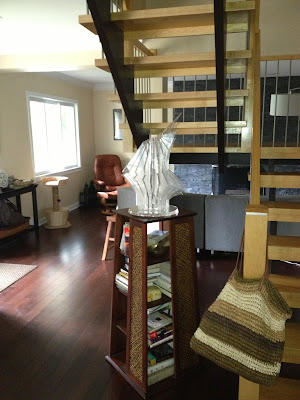So I finished a small home project this week.
Years ago, I must have been 13 or 14 my father and I collaborated on a series of Plexiglass sculptures. It was a way to meld his hand skills and my developing math and coding skills. The project came about as a BASIC programming exercise utilizing the then amazing high resolution graphics (Wikipedia says it had a 256 pixel display - I don't even recall it being that high). Anyway, we would start with a shape - in this case it looks like a triangle - and then a series of FOR/NEXT loops would increment one or both of the coordinates of the points causing them to shift. In some cases the incrementing value was also incremented causing the point not only to move, but to accelerate. Dad would then take the image, copy it into one page per piece, blow it up to actual size (there was no real scale or calibration here, just made it bigger), and then proceed to cut the pieces out of acrylic. The assembly laid out the pieces in a circle, doubling all but the ends of the sequence to give it a sort of periodic flow. I think we did about 8. I used to have one of the simpler patterns in my apartment, simpler plastic but a more complex assembly involving a lamp to try to cause the pieces to edge light. Bee had one, Lois had one, but my all time favorite was this one. I called it "The Samurai."
This piece lived at my folk's house in Chicago and so it was part of the big move back in 2010. It turned out I packed it poorly and when we finally opened the box in the fall of 2011 the piece has been severely damaged with at least half of the profile pieces having broken off. I've been looking for a picture of it out of the box, but truth be told since it was my own fault and I was a little upset I think I decided not to take pictures. The upside, if there was an upside was that all of the breaks looked clean, no shattered bits, and many of the breaks actually were at the joint. So instead of throwing the thing away I just put it in a box hoping some time down the line I would get to fix it.
Some time down the line turned out to be 2 years later in the summer of 2013.
One of the things that had been keeping me from proceeding was that I never learned from my dad what the cement was. Finally one night I just balls it and typed "acrylic cement" into Amazon and picked the one that looked the most likely. We were underway. Next I needed a jig, or actually more of a story stick. off to the scene shop.
You can sort of see the state of things here in the photo at the shop. What I needed was a gauge I could clamp to a piece that was there in order to place one of the pieces that had snapped off. Looking at the spacing and doing some math I came up with a wedge that was 1/4" wide at the root and then opened up at 7 degrees on both sides. The last step was to rip a groove in the face of the gauge to make a spot for the clamps to grab on without having to grab the next piece.
Back home to the garage.
Here's the starting point of the refurbishment.
This is setting in the first piece. You can see on the base that when the parts snapped off they left some marks (sometimes some shards) where they had been. I was able to use those along with the gauge stick to place things properly. Mostly it worked pretty well.
As a side note, the brown handled spring clamp in that photo was my dad's, probably one he obtained from Plastics Incorporated in Rosemont where he learned to work with Plex at a company owned by a college buddy. Something about sitting in my basement working on acrylic with some of the original tools just like my father had was almost a spiritual experience. In particular, the smell of the cement brought back many, many memories.
I learned a little bit along the way. First up was that the original jig used to make the piece had some drift in it. If I remember correctly, dad set up to mount all the pieces simultaneously using a piece of plywood with a bunch of radiating fins on it. This eliminated the possibility of iterated error, but also meant the placement was only as accurate as the jig. Suffice it to say the jig wasn't exactly accurate.
As I moved around the piece it became clear that a little shimming would be necessary. Also, after one or two pieces I learned that I couldn't sit my gauge on the base. Although it made the pieces easier to clamp it also made the gauge harder to remove after the piece had set. And as if that wasn't enough, if placed on the base, the capillary action that makes the cement penetrate the joint also caused it to creep up the gauge and leave a mark on the adjacent piece.
Here you can see some of the snapping action from above. You can also see the gauge clamping process, and if you look at the piece on the left (that was the first piece I replaced) you can see the creeping cement where the gauge block was.
I managed to do two pieces a day for about two weeks. I would do one going out the door in the morning and then another coming in the door in the evening. The cement would set within minutes, but would need several hours to reliably hold the weight of each piece. Even then I could sometimes correct a little bit of a lean with a strategic shim. The can says the cement cures over 48 hours and continues to strengthen even after that.
All in all fairly successful. Now after two years of sitting broken in a closet I have one of the cooler things I ever did back on display.











2 comments:
Cool piece! Have you tried putting a ring of LEDs under it?
We did a couple with lamps long ago. Nothing with LEDs. As is the edges are polished and so they wouldn't light up as well as they would as if they were matte. I did have exactly the same thought when I finished the repair.
Post a Comment